





Saffron
Saffron (crocus) – a perennial plant of family Iris, growing in the woods, steppes and meadows. The saffron reaches 15-20 cm in height, consists of a stalk, green leaves and 2-3 flowers with three stigmas of orange color. The saffron in the fall from October to November or in the spring flowers of white, orange, blue, violet shades blossoms. Fruits of a plant are three-cell boxes with small angular seeds. Asia Minor is considered the presumable homeland of a plant.
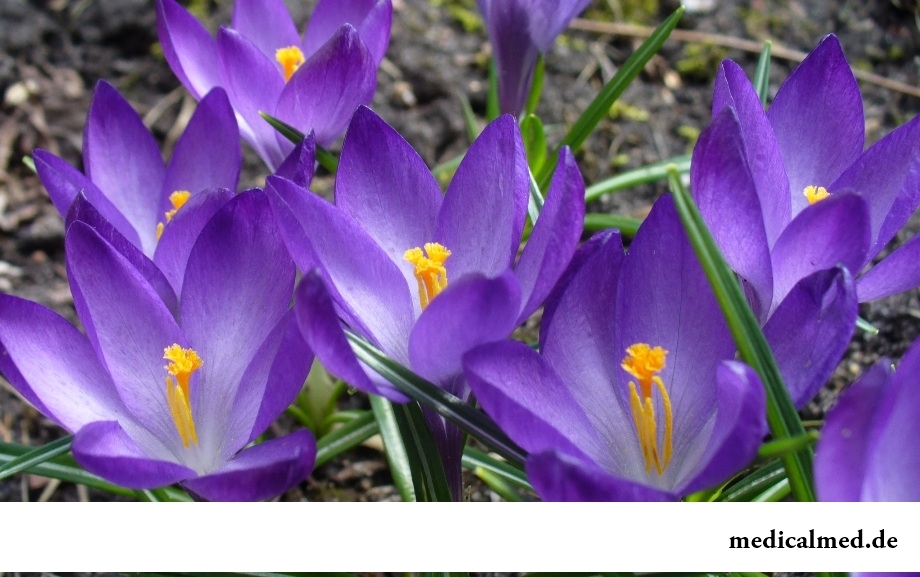
In the nature there are about 80 types of a saffron, some of them are included in the Red List. The most widespread and known types of a saffron are:
- Alatavsky;
- Banat;
- Spring;
- Nigro Fight;
- Pallas;
- Ремебранс;
- Geyfelya;
- Zolotistotsvetkovy;
- Mesh;
- Narrow-leaved.
Flavonoids, glycosides, protocrocin, carotinoids, crocin, group B vitamins, starch and essential oils (from 0,4% to 1,3%) rich in cineol and сафранол are a part of a saffron.
Useful properties of a saffron
Useful properties of a saffron are caused by rich vitamin and glikozidny structure. The saffron is efficient means at:
- To asthma;
- Whooping cough;
- To phlegm;
- Atherosclerosis;
- Meteorism;
- Cough;
- To sleeplessness;
- Depressions;
- Alzheimer's disease;
- Blood spitting;
- To heartburn;
- Premenstrual syndrome;
- Premature ejaculation;
- Infertility;
- Alopecias.
Use of a saffron as aphrodisiac is also widely known.
The saffron is a good source of minerals, such as copper, potassium, calcium, manganese, iron, selenium, zinc and magnesium. Potassium is an important component of cells and liquids of an organism which helps to regulate the heart rate and arterial pressure.
Manganese and copper are used by an organism as cofactors for antioxidant enzyme of a superoxide scavenger. Iron is necessary for development of erythrocytes and as a cofactor for enzymes cytochrome of oxidases.
Besides the saffron is rich in many vital vitamins, including the vitamin A, folic acid, Riboflavinum, Niacinum and vitamin C necessary for maintenance of immunity of an organism.
Medicinal properties of a saffron which are effective at are experimentally confirmed:
- Alarming frustration;
- Astenozoospermiya;
- Heart hypertrophies;
- Toxic damage of a liver;
- Colorectal cancer;
- Diabetic neuropathy;
- Dysmenorrheas;
- Erectile dysfunction;
- Hypertensions;
- Liver cancer;
- Occlusions of an average brain artery;
- Multiple sclerosis;
- Pancreatic cancer;
- Psoriasis;
- Diseases of respiratory system;
- Healing of wounds.
Use of a saffron
Useful properties of a saffron were known at the time of Ancient Egypt and Rome where the plant was applied as dye, medicine, was added to perfumery and cookery. From there it was delivered to China, and then is widespread on all Europe in the Middle Ages. In Morocco the saffron was used for removal of a dentagra when at children the first teeth grew, and in France in the period of the Renaissance of the woman made up with mix from a lemon and a saffron hair, for obtaining resistant color.
Today in the world Iran, India and Spain which are recognized by producers of the most high-quality spice are considered as the largest importers of a saffron.
The saffron is widely applied in cookery and is the most expensive spice in the world. The high cost of a saffron is caused by the fact that flowers of a plant contain only three stigmas from which spice turns out. To receive a floor of kilogram of spice it is necessary to process from 70000 to 250000 flowers which gather manually in the fall when flowers completely reveal.
Upon purchase of a saffron it is necessary to pay attention to color of spice, first of all. The saffron of high quality has to be evenly painted, bright red or dark orange color. Spice can be bought in the form of powder or stigmas (threads).
In cookery the saffron is used to give to dishes saturated color and aroma. This spice is irreplaceable for such dishes as risotto, bouillabaisse and a paella.
Also in cookery the saffron is applied at preparation of soups, sauces and gas stations to salads.
In the Indian cookery the saffron is added to milk and used in a diet daily as means the improving digestion purifying blood and which is taking off fatigue and exhaustion.
In manufacturing industry extracts of a saffron are used in perfumery, and also as dye for fabric.
In traditional medicine the saffron is a part of the antidepressants, drugs improving digestion antiseptic and anticonvulsants.
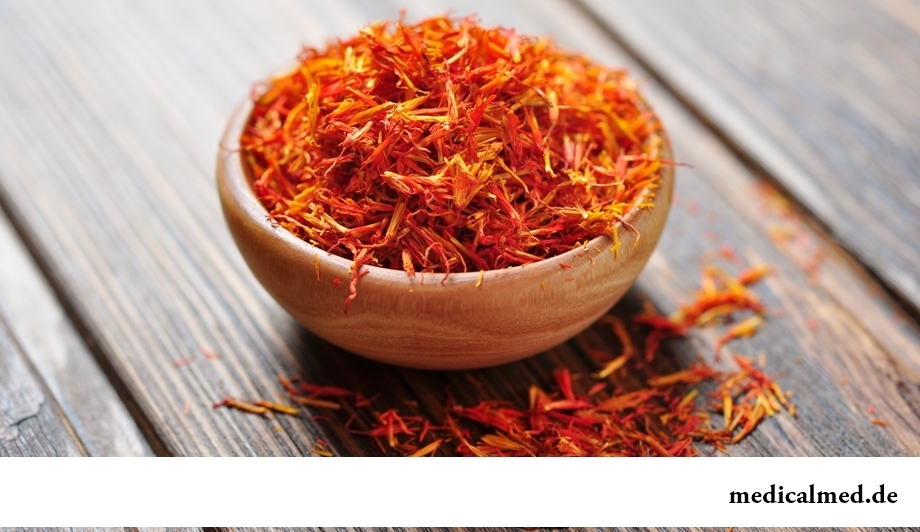
Harm of a saffron
Use of a saffron as medicine is safe provided that the term of reception does not exceed six weeks. At longer use of drugs such side effects as dryness in a mouth, concern, dizziness, drowsiness, nausea, appetite change, a headache and allergic reactions according to reviews can evolve from a saffron.
Use of a saffron according to reviews in high doses is unsafe and can lead to poisoning, yellowing of skin, eyes and mucous membranes, vomiting, diarrhea, bleeding from a nose. The saffron dose in 12-20 grams can lead to death.
Pregnant women and in the period of a lactation should not use a saffron in bigger quantity, than that which usually contains in food. The bigger quantity of a saffron can lead to reductions of a uterus and abortion.
With care it is necessary to use a saffron at bipolar disorder and to people with an allergy to a ryegrass.
To tell even the shortest and simple words, we involve 72 muscles.

The way of life of people promptly changes from year to year: if about ten years ago the personal computer was not in each family...
Section: Articles about health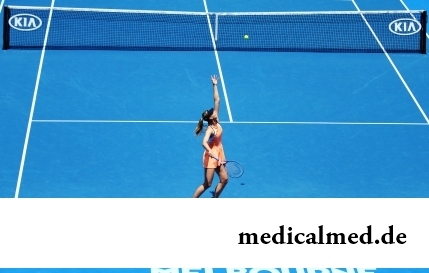
Proofs of efficiency of Mildronate at treatment of coronary heart disease with stenocardia can be found in many publications of the end of the twentieth century. Researches were conducted since 1984, including placebo - controlled effects. In total клиничес...
Section: Articles about health
Heart disease and blood vessels lead to disturbance of blood supply of bodies and fabrics that involves failures in their work, deterioration in health of the person, decrease in its working capacity and standard of living. Annually more than 17 million inhabitants of our planet perish from pathologies such....
Section: Articles about health
The naturopathy sometimes moves as the new direction of medicine, something like fashionable hobby, and there is nothing farther from the truth....
Section: Articles about health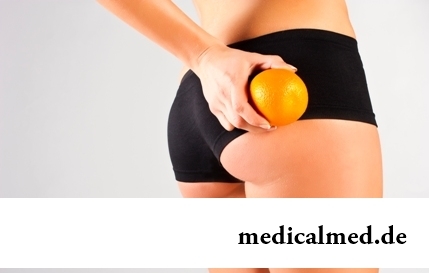
Cellulitis - very widespread cosmetic shortcoming which arises approximately at 80% of women sooner or later. Emergence it is connected with change of structure of a hypodermic fatty layer. At the same time on the surface of skin at first there are roughnesses (cambers...
Section: Articles about health
About influence of fasting days on an organism it is told much – both about advantages, and about shortcomings. It is considered that fasting day in the form of a short-term monodiet is useful, promoting effective removal of slags from an organism whereas irregular, excessively long, spontaneous fasting days lead only to deterioration in health. How to derive benefit from the sparing diet and not to do much harm to itself? Let's consider the main advantages and shortcomings of fasting days and their influence on an org...
Section: Articles about health
It is known that the person for 80% consists of water which participates in all processes of an organism. The person loses liquid daily – in...
Section: Articles about health
Life does not indulge the modern woman special emotional comfort and carelessness. The fatigue, troubles at work, misunderstanding in a family and various illnesses immediately affect a condition of hair and skin. And to look safe and attractive so хоч...
Section: Articles about health
The person, as well as all other beings living on our planet feels weather changing. It is the normal meteosensitivity which is not causing to healthy people of special troubles. Meteodependence, on the contrary, is the morbid condition which is characterized by an exacerbation of chronic illnesses at change of air temperature, differences of atmospheric pressure, wind strengthening, magnetic storms and other "surprises" on which the nature is so generous. The people suffering from meteodependence have to з...
Section: Articles about health
To look healthy and means well-groomed not only to be pleasant to people around, but also to feel strong, sure and taken place. To Spa...
Section: Articles about health
What is in our understanding weeds? It plants which are considered to be suitable only for compost pits and feeding of animals. Meanwhile, among the weeds growing literally under legs it is possible to find the mass of the officinal herbs possessing invaluable Paul...
Section: Articles about health
The unpleasant feelings connected with spring breakdown are familiar almost to each of us. Often happens that in March-April on the person weakness leans: he suffers from drowsiness, complains of bad mood, loss of interest in life and failures in affairs....
Section: Articles about health
The summer of this year in Russia was very ambiguous. Regions suffered from a merciless heat, from pouring rains, from times...
Section: Articles about health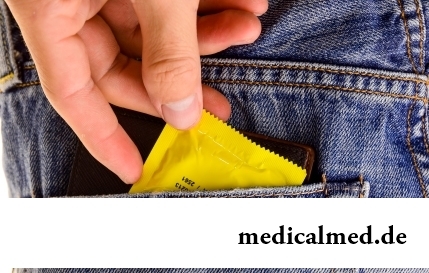
Today about 30 diseases, sexually transmitted are known. Wide circulation of these illnesses is extremely promoted by the dual attitude towards them: on the one hand, most of people know about "shameful" diseases and not a stirrup very little...
Section: Articles about health
You heard that laughter prolongs life? Researchers did not manage to establish longevity direct link with sincere fun yet, but several facts confirming beneficial influence of risibility on the state of health are clinically proved....
Section: Articles about health
Diapers for adults – individual one-time means of hygiene which in some situations is irreplaceable, and from such situats...
Section: Articles about health
At this plant there are a lot of names: tuberiferous sunflower, Jerusalem artichoke, solar root, earth pear. Contrary to popular belief, it is not an exotic plant at all. The wild girasol grows in a midland of Russia practically everywhere: at the edges of roads...
Section: Articles about health
It would seem, to buy drugs in Moscow does not make a problem – a drugstore, and not one, is available for each resident of the capital within walking distance. And, nevertheless, Internet drugstores become more popular – what it is possible to explain such phenomenon with? Actually there is a lot of reasons and if to formulate them it is short, then the most suitable word will be - "conveniently". We suggest to get acquainted in more detail with pluses and minuses of online drugstores that buying drugs, not to make the wrong choice....
Section: Articles about health
Summer in the heat. Many are going to spend vacation abroad. Travelers the tender seas, rest on beaches wait, for survey достоп...
Section: Articles about health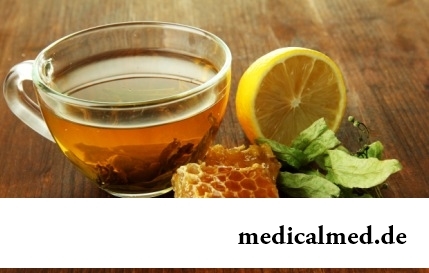
Cold – a state known to everyone which is followed by cold, cough, high temperature, a pharyngalgia. Often the first that we begin to do in hope again to become healthy – to accept medicines which are not always harmless, then...
Section: Articles about health
It is difficult to revaluate importance of kidneys for an organism. These bodies not only perform work on purification of blood of decomposition products and removal of excess liquid. They are responsible also for production of some hormones necessary for maintenance of a normality of a bone tissue, and also for a producing red blood cells – erythrocytes....
Section: Articles about health
"Epilepsy" doctors made the diagnosis in antique times. Displays of an illness and pattern of its development are very well studied. Odes...
Section: Articles about health
Each of us repeatedly noticed that the people having the same passport age are sometimes not similar on one-years at all. One at the age of 40-45 years already looks almost an old man, and another and in 60 is young, vigorous and full of life. The matter is that state нашег...
Section: Articles about health
The sclera and mucous membrane of an eye are intensively supplied with blood vessels which problem - to saturate nervous tissues of body with nutrients and oxygen. In a normality vessels are almost not noticeable, however at their expansion (owing to thinning of walls) become visible, painting a sclera in red color. Quite often red eyes - the signal of any trouble in an organism caused as external irritants, allergens, and diseases which need in about...
Section: Articles about health
For the city dweller the fitness is the most convenient sport. It is enough to acquire the subscription to the gym to receive to a toast...
Section: Articles about health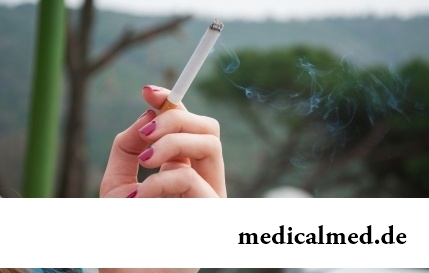
Statistically, in Russia about 34% of citizens smoke. Most of consumers of tobacco has problems with health sooner or later. Not only smokers, but also their relatives suffer. Besides, cigarettes are expensive, and need of their acquisition heavy bry...
Section: Articles about health
In consciousness of our many compatriots idea that folk remedies if are no more effective, than medicinal "chemistry" strongly took roots, then are precisely less harmful. Unfortunately, it is not always fair: some methods of treatment consecrated with "century national experience" can work so on the patient that it will need urgent intervention of physicians....
Section: Articles about health
